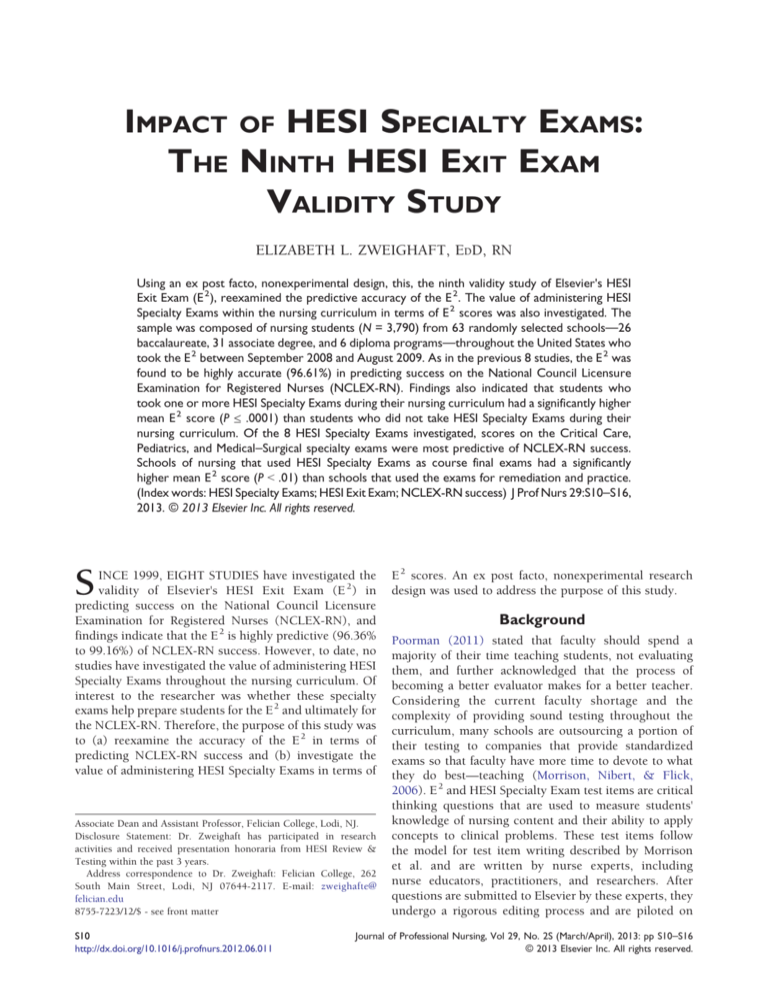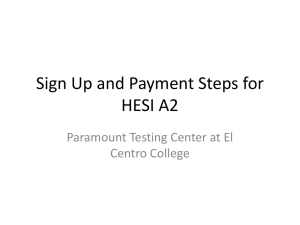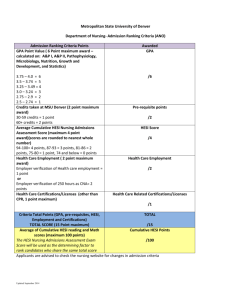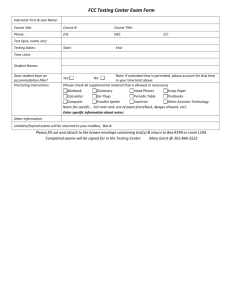
IMPACT OF HESI SPECIALTY EXAMS:
THE NINTH HESI EXIT EXAM
VALIDITY STUDY
ELIZABETH L. ZWEIGHAFT, EDD, RN
Using an ex post facto, nonexperimental design, this, the ninth validity study of Elsevier's HESI
Exit Exam (E 2), reexamined the predictive accuracy of the E 2. The value of administering HESI
Specialty Exams within the nursing curriculum in terms of E 2 scores was also investigated. The
sample was composed of nursing students (N = 3,790) from 63 randomly selected schools—26
baccalaureate, 31 associate degree, and 6 diploma programs—throughout the United States who
took the E 2 between September 2008 and August 2009. As in the previous 8 studies, the E 2 was
found to be highly accurate (96.61%) in predicting success on the National Council Licensure
Examination for Registered Nurses (NCLEX-RN). Findings also indicated that students who
took one or more HESI Specialty Exams during their nursing curriculum had a significantly higher
mean E 2 score (P ≤ .0001) than students who did not take HESI Specialty Exams during their
nursing curriculum. Of the 8 HESI Specialty Exams investigated, scores on the Critical Care,
Pediatrics, and Medical–Surgical specialty exams were most predictive of NCLEX-RN success.
Schools of nursing that used HESI Specialty Exams as course final exams had a significantly
higher mean E 2 score (P b .01) than schools that used the exams for remediation and practice.
(Index words: HESI Specialty Exams; HESI Exit Exam; NCLEX-RN success) J Prof Nurs 29:S10–S16,
2013. © 2013 Elsevier Inc. All rights reserved.
S
INCE 1999, EIGHT STUDIES have investigated the
validity of Elsevier's HESI Exit Exam (E 2 ) in
predicting success on the National Council Licensure
Examination for Registered Nurses (NCLEX-RN), and
findings indicate that the E 2 is highly predictive (96.36%
to 99.16%) of NCLEX-RN success. However, to date, no
studies have investigated the value of administering HESI
Specialty Exams throughout the nursing curriculum. Of
interest to the researcher was whether these specialty
exams help prepare students for the E 2 and ultimately for
the NCLEX-RN. Therefore, the purpose of this study was
to (a) reexamine the accuracy of the E 2 in terms of
predicting NCLEX-RN success and (b) investigate the
value of administering HESI Specialty Exams in terms of
Associate Dean and Assistant Professor, Felician College, Lodi, NJ.
Disclosure Statement: Dr. Zweighaft has participated in research
activities and received presentation honoraria from HESI Review &
Testing within the past 3 years.
Address correspondence to Dr. Zweighaft: Felician College, 262
South Main Street, Lodi, NJ 07644-2117. E-mail: zweighafte@
felician.edu
8755-7223/12/$ - see front matter
S10
http://dx.doi.org/10.1016/j.profnurs.2012.06.011
E 2 scores. An ex post facto, nonexperimental research
design was used to address the purpose of this study.
Background
Poorman (2011) stated that faculty should spend a
majority of their time teaching students, not evaluating
them, and further acknowledged that the process of
becoming a better evaluator makes for a better teacher.
Considering the current faculty shortage and the
complexity of providing sound testing throughout the
curriculum, many schools are outsourcing a portion of
their testing to companies that provide standardized
exams so that faculty have more time to devote to what
they do best—teaching (Morrison, Nibert, & Flick,
2006). E 2 and HESI Specialty Exam test items are critical
thinking questions that are used to measure students'
knowledge of nursing content and their ability to apply
concepts to clinical problems. These test items follow
the model for test item writing described by Morrison
et al. and are written by nurse experts, including
nurse educators, practitioners, and researchers. After
questions are submitted to Elsevier by these experts, they
undergo a rigorous editing process and are piloted on
Journal of Professional Nursing, Vol 29, No. 2S (March/April), 2013: pp S10–S16
© 2013 Elsevier Inc. All rights reserved.
IMPACT OF HESI SPECIALTY EXAMS
various HESI exams with thousands of uses. The items
are edited again based on item analysis data obtained
from the piloting procedure (Morrison, Adamson, Nibert,
& Hsia, 2004). This is an arduous process that most
nursing faculty do not have the time or resources to
implement. Therefore, faculties are increasingly turning
to standardized testing to evaluate students and the
nursing curriculum.
Eight previously conducted studies have confirmed
that the E 2 is a highly accurate predictor of NCLEX-RN
success (Adamson & Britt, 2009; Langford & Young,
2013; Lauchner, Newman, & Britt, 1999; Lewis, 2005;
Newman, Britt, & Lauchner, 2000; Nibert & Young,
2001; Nibert, Young, & Adamson, 2002; Young &
Willson, 2012). The use of the E 2 within schools of
nursing has been the subject of numerous studies
(Bentley, 2006; Daley, Kirkpatrick, Frazier, Chung, &
Moser, 2003; DiBartolo & Seldomridge, 2005; Frith,
Sewell, & Clark, 2005). Harding (2010) conducted a
systematic literature review regarding the predictability
of exit exams and reported that the E 2 was highly
accurate in predicting NCLEX-RN success but not
failure. However, Nibert et al. (2002) reported that as
E 2 scores decreased, the percentage of NCLEX-RN
failures significantly increased. Furthermore, Nibert
et al. (2006) stated that the purpose of obtaining such
data was to assess students' risk for NCLEX-RN failure so
that faculty could assist them in remediating deficit areas,
thereby enhancing the probability of students' passing
the NCLEX-RN.
The E 2 and HESI Specialty Exams provide a measure of
external curriculum evaluation, which compares a
student or group of students to the overall student
population, and is conducted by sources outside the
college or university (Morrison et al., 2004). The
summary reports provided by the E 2 include content
area scores that can guide students' remediation efforts as
well as evaluate curricular strengths and weaknesses.
HESI Specialty Exams provide similar summary reports,
but the data described in these reports are related to one
specific clinical specialty area. Although a plethora of
research has been conducted regarding the validity of the
E 2 (Adamson & Britt, 2009; Langford & Young, 2013;
Lauchner et al., 1999; Lewis, 2005; Newman et al., 2000;
Nibert & Young, 2001; Nibert et al., 2002; Young &
Willson, 2012), no research has been conducted to
determine the worth of administering HESI Specialty
Exams throughout the nursing curriculum.
Conceptual Framework
Classical test theory described by Crocker and Algina
(1986) and critical thinking theory described by Paul
(1990) were used as the theoretical basis for developing a
model for writing critical thinking test items described by
Morrison et al. (2006). This model was used to formulate
the conceptual framework for the eight previously
conducted studies that examined the accuracy of the E 2
in predicting NCLEX-RN success. The model, described
S11
in detail by Morrison et al. (2004), was also used for
this study.
Instruments
Three instruments were used to collect the data for this
study: the E 2, HESI Specialty Exams, and the Ninth
Validity Study Questionnaire. The E 2 and HESI
Specialty Exams are produced by Elsevier, and the
Ninth Validity Study Questionnaire was designed by
the researcher.
E 2 and HESI Specialty Exams
The E 2 is a 160-item comprehensive exam, of which 10
items are pilot items that do not contribute to the
students' scores. It is often administered during the
final semester, or quarter, of the nursing curriculum.
The E 2 test blueprint is reflective of the NCLEX-RN test
plan (National Council of State Boards of Nursing
[NCSBN], 2010).
HESI Specialty Exams are 55-item content-focused
exams. Five of the questions included in these exams are
pilot items and do not contribute to the student's scores.
These exams are typically administered at the conclusion
of a nursing course and are usually counted as some
portion of the student's final grade in that course. This
study focused on the HESI Specialty Exams that had
testing cohorts of greater than 300, which included the
following eight exams: Critical Care, Fundamentals,
Maternity, Management, Medical–Surgical, Pediatrics,
Psychiatric–Mental Health, and Pharmacology.
Questions on the E 2 and the HESI Specialty Exams are
reflective of the test item formats used by the NCSBN
during the study period and include multiple-choice,
multiple-response, fill-in-the-blank, hot-spot, chart/exhibit, and drag-and-drop items (NCSBN, 2010). Scores
on the E 2 and the HESI Specialty Exams range from 0 to
approximately 1800, with the highest score dependent on
the difficulty level of the test items included in the exam.
The reliability of the E 2 and the HESI Specialty Exams is
determined by calculating the Kuder–Richardson Formula 20 (KR20) for every exam that is returned to
Elsevier for scoring. An estimated KR20 for these exams
is calculated prior to their administration and is based on
data obtained from all prior administrations of the test
items included in the exam (Morrison et al., 2004). The
estimated reliability, or KR20, for the E 2s and the HESI
Specialty Exams administered during the study period
ranged from 0.84 to 0.92. The validity of the E 2 has been
established by eight previously conducted studies. With a
total student sample of 45,325 for the prior studies,
findings indicated that the E 2 was 96.36% to 99.16%
accurate in predicting NCLEX-RN success (Adamson &
Britt, 2009; Langford & Young, 2013; Lauchner et al.,
1999; Lewis, 2005; Newman et al., 2000; Nibert &
Young, 2001; Nibert et al., 2002; Young & Willson,
2012). Measurement of content validity for the HESI
Specialty Exams is an ongoing process. Course syllabi
from colleges and universities across the U.S. are
reviewed by Elsevier's nurse educators and researchers
S12
ELIZABETH L. ZWEIGHAFT
at least three times annually to determine what content is
currently being taught in schools of nursing. HESI
Specialty Exams are designed to evaluate the clinical
content described in these syllabi (Morrison et al.).
2,332 (61.53%) were users of specialty exams, and
1,458 (38.47%) were nonusers of specialty exams.
Table 1 describes users and nonusers of HESI Specialty
Exams by program type.
Ninth Validity Study Questionnaire
Findings
The Ninth Validity Study Questionnaire, which was used
to collect data for this investigation, was designed and
pretested by the researcher. It consisted of 19 multiplechoice questions with open comment fields. The purpose
of the questionnaire was to obtain information from
participating deans and directors regarding policies
established at their college or university for administration of the E 2 and HESI Specialty Exams. Specifically, the
participating deans and directors were asked to describe
policies related to the use of E 2 scores and HESI Specialty
Exam scores for benchmarking and remediation. The
questionnaire also requested information regarding
student outcomes on the NCLEX-RN. To maintain
confidentiality, deans and directors removed students'
identifying information before uploading their responses
to Elsevier.
Eight previously conducted studies determined the
predictive accuracy of the E 2 based on students who
scored 900 and higher, which is the score at which
Elsevier describes students as predicted to pass the
NCLEX-RN. Of the 3,790 students who participated in
this study, 1,394 (36.78%) scored 900 and higher on the
E 2. NCLEX-RN results were reported for 1,326 of these
1,394 students, and 1,281 (96.61%) of the 1,326 students
for whom licensure exam outcomes were available passed
the NCLEX-RN on their first attempt.
A Welch–Satterthwaite's t test was used to determine if
there was a difference in mean E 2 scores of users and
nonusers of specialty exams. The mean E 2 score for users
was 865.7, and the mean E 2 score for nonusers was 837.3.
Findings indicated that users had significantly higher E 2
scores than nonusers (P ≤ .0001), which according to
Salkind (2010) is a medium effect size of 0.24. E 2 scores
were further analyzed by program type. The mean E 2
score for BSN users was 848.4, and the mean E 2 score for
BSN nonusers was 824.5. Findings indicated that BSN
users had significantly higher E 2 scores than BSN
nonusers (P = .0004), which according to Salkind is a
small effect size of 0.19. The mean E 2 score for ADN users
was 877.1, and the mean E 2 score for ADN nonusers was
847.4. Findings indicated that ADN users had significantly higher E 2 scores than ADN nonusers (P ≤ .0001),
which according to Salkind is a large effect size of 0.85.
The mean E 2 score for diploma users was 866.4, and the
mean E 2 score for diploma nonusers was 830.3. Findings
indicated that the E 2 scores of diploma users and
nonusers were not significantly different (see Table 2).
Odds ratio analyses were conducted to determine
which of the eight HESI Specialty Exams that had testing
cohorts of greater than 300 were predictive of NCLEXRN success. The score most often established by schools
of nursing as an E 2 benchmark is 850 (Young & Willson,
2012). Therefore, scores of 850 and higher were used to
conduct these odds ratio analyses. Findings indicated
that all eight HESI Specialty Exams were significantly
predictive (P = .0001 to .0034) of NCLEX-RN success.
The three most predictive specialty exams of NCLEX-RN
success were Critical Care, Pediatrics, and Medical–
Surgical (see Table 3).
Users of the specialty exams were asked how they
implemented these exams within their curriculum.
Responding deans and directors from 36 of the 63
schools (57.14%) answered the question. Of the 36
respondents, 6 (16.67%) indicated that the specialty
exams were used as final exams, 6 (16.67%) for practice,
9 (25.00%) for remediation only, and 15 (41.66%)
responded “other.” Student self-assessment, knowledge
of national ranking, and as a course test grade were the
most often cited “other” implementation strategies.
Methods
After institutional review board approval was obtained,
participating schools of nursing reported school policies,
strategies, and deidentified student cohort information.
An ex post facto, nonexperimental design was used to
compare E 2 scores and NCLEX-RN outcomes of students
who took one or more HESI Specialty Exams during their
nursing curriculum (users) with E 2 scores of students
who did not take HESI Specialty Exams during their
nursing curriculum (nonusers). The population consisted of students who took the E 2 between September 1,
2008, and August 31, 2009.
A list of user and nonuser schools was enumerated, and
a random number generator was applied. Deans and
directors from 97 randomly selected schools of nursing
were invited to participate in the study. The random
sample of schools was stratified using the three program
types—baccalaureate (BSN), associate degree (ADN), and
diploma—to match the distribution of candidates from
each program type who took the NCLEX-RN during the
study period. Those who did not respond within two
weeks received a follow-up e-mail or telephone call, and
two weeks after the initial follow-up, if there was still no
response, a final follow-up was made to ensure that the
surveys were received. Of the 97 schools invited to
participate, deans and directors from 63 (64.95%) schools
responded to the questionnaire, 26 BSN, 31 ADN, and 6
diploma programs. Of the 63 responding deans and
directors, 43 (68.25%) reported that they were users of
specialty exams, and 20 (31.75%) reported that they were
nonusers of specialty exams. From the 63 randomly
selected schools, 3,790 nursing students participated in
this study: 1,489 (39.29%) BSN students, 2,103 (55.49%)
ADN students, and 198 (5.22%) diploma students. A
power analysis indicated that the sample size was
adequate for this investigation. Of the 3,790 students,
IMPACT OF HESI SPECIALTY EXAMS
S13
Table 1. Users and Nonusers of HESI Specialty Exams by Program Type
Users and nonusers
School users
School nonusers
Total schools
Student users
Student nonusers
Total students
Total
BSN
Associate
Diploma
43 (68.25%)
20 (31.75%)
63 (100.00%)
2,332 (61.53%)
1,458 (38.47%)
3,790 (100.00%)
15 (57.77%)
11 (42.31%)
26 (100.00%)
862 (57.89%)
627 (42.11%)
1,489 (100.00%)
23 (74.19%)
8 (25.81%)
31 (100.00%)
1,295 (61.58%)
808 (38.42%)
2,103 (100.00%)
5 (83.33%)
1 (16.66%)
6 (100.00%)
175 (88.38%)
23 (11.62%)
198 (100.00%)
Additionally, some faculty reported that specialty exam
cohort scores were used as a component of their
systematic curriculum evaluation. Table 4 describes
these frequencies.
The mean E 2 score for schools that administered HESI
Specialty Exams as course final exams was 875.2 (N =
524), and the mean E 2 score for schools that used the
specialty exams for remediation and practice was 859.5
(N = 868). A Welch–Satterthwaite's t test indicated that
schools that implemented HESI Specialty Exams as
course final exams had a significantly higher mean E 2
score (P b .01) than schools that implemented HESI
Specialty Exams for practice and remediation,
which according to Salkind (2010) is a small effect size
of 0.15 (see Table 5).
Discussion and Recommendations
The predictive accuracy of the E 2 for this ninth validity
study (96.61%) remains within the range of the eight
previous validity studies (96.36% to 99.16%) that were
conducted over the past 13 years. Once again, the E 2 was
determined to be a highly accurate predictor of NCLEXRN success. Because of its predictability, scoring data
provided by the E 2 can confidently be used by nursing
faculty and students to guide remediation, thereby
reducing students' risk of failing the licensing exam and
increasing NCLEX-RN pass rates. Additionally, E 2 data
can be tracked over time and used as a measure of
external curriculum evaluation, which provides quantifiable evidence of curricular and faculty effectiveness
that can be included in schools' accreditation or
reaccreditation reports.
Each previously conducted E 2 validity study examined
one or more variables other than the predictive accuracy
of the E 2. For the first time, the value of administering
HESI Specialty Exams throughout the nursing curriculum was investigated in terms of E 2 scores. Findings
indicated that students benefited from taking one or
more HESI Specialty Exams during their nursing
curriculum. They had a significantly higher mean E 2
score than those who did not take HESI Specialty Exams
during their nursing curriculum. Newman et al.
(2000) reported that students with high E 2 scores are
significantly more likely to pass the NCLEX-RN than
those with low E 2 scores. Furthermore, when comparing
E 2 scoring intervals, Nibert et al. (2002) and Lewis
(2005) found that NCLEX-RN failures increase significantly as E 2 scores decrease. Therefore, it can be
conjectured that if administering HESI Specialty Exams
helps students achieve higher E 2 scores, then it is
likely that administering HESI Specialty Exams throughout the nursing curriculum helps candidates achieve
NCLEX-RN success.
The use of HESI Specialty Exams exposes students to
standardized testing early in the curriculum, which
probably explains why users of specialty exams had
higher E 2 scores than nonusers of specialty exams. Like
the E 2, HESI Specialty Exams contain nationally normed,
critical thinking test items. Unlike the E 2, which is
usually administered during the last semester or quarter
of the curriculum when little time remains for remediation before taking the NCLEX-RN, HESI Specialty
Exams are administered throughout the nursing curriculum. Consequently, remediation needs can be identified
early and addressed as the student progresses through the
nursing program. The scoring reports provided by the
specialty exams are similar to those provided by the E 2,
but the specialty exam reports focus on one clinical area
Table 2. E 2 Scores of Users and Nonusers of HESI Specialty Exams by Program Type
Statistical findings
Program
type
Specialty
exam use
Number of
students
E 2 mean
score
SD
df
t test
P
BSN
Users
Nonusers
Users
Nonusers
Users
Nonusers
Users
Nonusers
862
627
1,295
808
175
23
2,332
1,458
848.4
824.5
877.1
847.4
866.4
830.3
865.7
837.3
110.7
141.0
107.4
108.3
97.5
91.6
108.7
123.7
1,145
3.53
.0004 ⁎
2,101
6.14
.0001 ⁎⁎
196
1.68
.0943
3,655
12.42
ADN
Diploma
Total
⁎ P b .001.
⁎⁎ P ≤ .0001.
.0001 ⁎⁎
S14
ELIZABETH L. ZWEIGHAFT
Table 3. Odds of Passing the NCLEX-RN When Scoring 850 and Higher on HESI Specialty Exams
95% Confidence interval
Specialty exam
Critical care
Pediatrics
Medical-Surgical
Fundamentals
Psychiatric
Maternity
Management
Pharmacology
n
328
655
1,099
600
1,350
802
693
590
Odds ratio
†
11.164
5.510
5.502
3.710
3.390
3.373
2.984
2.122
Lower
Upper
P
2.598
2.643
3.388
1.783
2.250
1.999
1.785
1.271
47.971
11.489
8.932
7.726
5.107
5.691
4.989
3.543
b .0001 ⁎⁎⁎
b .0001 ⁎⁎⁎
b .0001 ⁎⁎⁎
.0002 ⁎⁎
b .0001 ⁎⁎⁎
b .0001 ⁎⁎⁎
b .0001 ⁎⁎⁎
.0034 ⁎
⁎ P b .05.
⁎⁎ P b .001.
⁎⁎⁎ P ≤ .0001.
†
Odds ratio of passing the NCLEX-RN.
and provide an in-depth evaluation of students' mastery
of the content and concepts related to that particular
clinical area. Standardized testing administered throughout the curriculum also provides a measure of external
curriculum evaluation. Like E 2 data, specialty exam data
can be tracked over time to assess faculty and curricular
effectiveness, and these data also provide quantifiable
evidence that can be included in schools' accreditation or
reaccreditation reports.
Of the 63 participating schools of nursing, deans and
directors from 36 (57.14%) schools responded to the
question regarding strategies used to implement HESI
Specialty Exams within their school of nursing. Of the
36 respondents to this question, 41.67% indicated that
the specialty exams were used for practice and
remediation, whereas 16.67% of the respondents
indicated that they used the specialty exams as a
final exam. Although replacing final exams with
standardized exams relieves faculty from the arduous
task of writing test items and constructing final exams,
relatively few schools chose this implementation
strategy. However, the mean E 2 score was higher for
schools that administered the HESI Specialty Exams as
course final exams than the mean E 2 score for schools
that used these exams for practice and remediation. It
is likely that the consequences associated with taking
HESI Specialty Exams as course final exams incentivizes students to prepare more diligently for these
exams, which in turn helps them prepare for the E 2
and ultimately for the licensing exam.
Although faculty reported implementing HESI Specialty Exams for student self-assessment, course grades,
and for comparison to national norms, 41.66% chose the
open dialog response “other” to this question. Information provided by this open dialog choice can be used to
design future questionnaires so that subsequent studies
can compare more effectively specific implementation
strategies for specialty exams. It is possible that as more
studies are conducted that investigate the use of
HESI Specialty Exams throughout nursing curriculums,
faculty may become more comfortable with outsourcing
testing to companies that specialize in the scientific
development of standardized exams, thereby enabling
faculty to focus their time and effort on what they do
best—teaching nursing.
This initial study of HESI Specialty Exams compared
student outcomes of those who took one or more
specialty exams with those who took no specialty
exams—users and nonusers. These dichotomous data,
users versus nonusers, limited the data analysis to a
nonparametric design. Future studies should survey
users to determine how many and which HESI Specialty
Exams are administered so that the effect of administering multiple specialty exams may be investigated.
This study explored the value of individual HESI
Specialty Exams within the nursing curriculum as
Table 4. Strategies Used to Implement HESI Specialty Exams
Implementation strategies
Number of schools
Percent of schools
As final exams
Practice
Remediation only
Other
• Student self-assessment
• Knowledge of national ranking
• Course test grade
• Systematic curriculum evaluation
Total respondents
6
6
9
15
16.67
16.67
25.00
41.66
36
100.00
IMPACT OF HESI SPECIALTY EXAMS
S15
Table 5. E 2 Scores for HESI Specialty Exam Users by Implementation Strategy
Statistical Findings
Specialty exam
strategy
Number of
students
E 2 mean
score
SD
SE
df
t test
P
Final exam
Practice/Remediation
Total
524
868
1,392
875.2
859.5
109.6
112.5
4.8
3.8
1,145
2.56
.01 ⁎
⁎ P b .01.
measured by E 2 scores. Findings indicated that students
who took these specialty exams during their curriculum
scored significantly higher on the E 2 than those who did
not take specialtyexams during their curriculum. Out
of the eight HESI Specialty Exams that were investigated,
Critical Care, Pediatrics, and Medical–Surgical were
the three most predictive of NCLEX-RN success.
Findings indicated that those who scored 850 and higher
on these specialty exams were more likely to pass the
NCLEX-RN than those who scored lower than 850—
11.16 times more likely for Critical Care, 5.51 times more
likely for Pediatrics, and 5.50 times more likely for
Medical–Surgical.
Conclusions
2
The E and HESI Specialty Exams are standardized exams
that contain critical thinking test items and, as such,
evaluate students' ability to apply content and concepts to
clinical problems. Limitations such as curricular differences, varying faculty expertise, and students' individual
experiences may have influenced the findings of this
study. However, based on analyses of the data obtained,
the E 2 can be confidently used to evaluate students'
readiness for the NCLEX-RN, and HESI Specialty Exams
can be used to objectively evaluate students' curricular
achievements. Subject matter scores provided by these
exams can serve as a guide to remediation to help prepare
students for the licensure exam. HESI Specialty Exams
help prepare students for the E 2, and administration of
specialty exams throughout the nursing curriculum
promotes early remediation that can help ensure students'
success within the nursing program and ultimately on the
licensure exam. When HESI Specialty Exams are administered as course final exams, students score higher on the
E 2 than when specialty exams are used for practice and
remediation only. Therefore, implementing HESI Specialty Exams as final exams helps improve students' E 2 scores,
and the higher students score on the E 2, the more likely
they are to succeed the first time they take the NCLEXRN. Finally, the E 2 and HESI Specialty Exams provide
quantitative evidence of faculty and curricular effectiveness so that they can be used as a measure of external
curriculum evaluation.
References
Adamson, C., & Britt, R. (2009). Repeat testing with the HESI
Exit Exam—Sixth validity study. CIN: Computers, Informatics,
Nursing, 27, 393–397.
Bentley, R. (2006). Comparison of traditional and accelerated
baccalaureate nursing graduates. Nurse Educator, 31, 79–83.
Crocker, L., & Algina, J. (1986). Introduction to classical and
modern test theory. Belmont, CA: Wadsworth/Thomson
Learning.
Daley, L., Kirkpatrick, B., Frazier, S., Chung, M., & Moser, D.
(2003). Predictors of NCLEX-RN success in a baccalaureate
nursing program as a foundation for remediation. Journal of
Nursing Education, 42, 390–398.
DiBartolo, M. C., & Seldomridge, L. A. (2005). A review of
intervention studies to promote NCLEX-RN success of
baccalaureate students. Nurse Educator, 30, 166–171.
Frith, K. H., Sewell, J. P., & Clark, D. J. (2005). Best
practices in NCLEX-RN readiness preparation for baccalaureate
student success. CIN: Computers, Informatics, Nursing, 23,
322–329.
Harding, M. (2010). Predictability associated with exit
examinations: A literature review. Journal of Nursing Education,
49, 493–496.
Langford, R., & Young, A. (2013). Predicting NCLEX-RN
success with the HESI Exit Exam: Eighth validity study. Journal
of Professional Nursing, 29, S5–S9.
Lauchner, K., Newman, M., & Britt, R. (1999). Predicting
licensure success with a computerized comprehensive
nursing exam: The HESI Exit Exam. Computers in Nursing, 17,
120–125.
Lewis C. (2005). Predictive accuracy of the HESI Exit Exam
on NCLEX-RN pass rates and effects of progression policies on
nursing student Exit Exam scores. Dissertation Abstracts
International, 66, 154B (UMI No. 3195986).
Morrison, S., Adamson, C., Nibert, A., & Hsia, S. (2004).
HESI exams: An overview of reliability and validity. CIN:
Computers, Informatics, Nursing, 22, 220–226.
Morrison, S., Nibert, A., & Flick, J. (2006). Critical thinking
and test item writing (2nd ed.). Houston, TX: Health Education
Systems, Inc.
National Council of State Boards of Nursing. (2010). 2010
NCLEX-RN Test Plan. Retrieved January 11, 2013, from https://
www.ncsbn.org/1287.htm.
Newman, M., Britt, R., & Lauchner, K. (2000). Predictive
accuracy of the HESI Exit Exam: A follow-up study. Computers
in Nursing, 18, 132–136.
Nibert, A., Adamson, C., Young, A., Lauchner, K., Britt, R., &
Hinds, M. (2006). Choosing a theoretical framework to guide
HESI Exit Exam research. Journal of Nursing Education, 45,
303–307.
Nibert, A., & Young, A. (2001). A third study on predicting
NCLEX success with the HESI Exit Exam. Computers in
Nursing, 19, 172–178.
Nibert, A., Young, A., & Adamson, C. (2002). Predicting
NCLEX success with the HESI Exit Exam: Fourth annual
validity study. CIN: Computers, Informatics, Nursing, 20,
261–267.
S16
Paul, R. (1990). Critical thinking: What every person needs to
survive in a rapidly changing world. Rohnert Park, CA: Center for
Critical Thinking and Moral Critique.
Poorman, S. (2011). Faculty matters column. Nursing
Education Perspectives, 32, 8–9.
ELIZABETH L. ZWEIGHAFT
Salkind, N. J. (2010). Statistics for people who (think they) hate
statistics (4th ed.). Thousand Oaks, CA: Sage.
Young, A., & Willson, P. (2012). Predicting NCLEX-RN
success: The seventh validity study of the HESI Exit Exam. CIN:
Computers, Informatics, Nursing, 30, 55–60.




